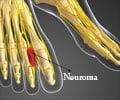Treatment of Tarsal Tunnel Syndrome
Treatment of tarsal tunnel syndrome may be conservative or surgical.
Treatment of tarsal tunnel syndrome depends upon the cause, severity and duration of the nerve compression. Proper evaluation and correct diagnosis of the tarsal tunnel syndrome is essential for the appropriate treatment. Prompt treatment prevents the progression of disease condition, which may lead to loss of nerve functioning.
Treatment of tarsal tunnel syndrome includes the following-
- Identification and treatment of risk factors: The cause and risk factors for tarsal tunnel syndrome should be identified and treated.
- Conservative methods: Tips that provide relief of pain and discomfort in tarsal tunnel syndrome include:
- Give the foot adequate rest. A cast may be necessary in some cases to restrict movement.

- Keep an ice pack on the affected area for 20 minutes to reduce swelling.
- Ultrasound and physical therapies also help to reduce the symptoms.
- The use of customized shoes or bracing may also benefit some patients.
- Weight loss also helps to reduce symptoms.

- Medications: Oral non-steroidal anti-inflammatory drugs (NSAIDS) and injectable corticosteroids are prescribed to relieve the pain and to treat inflammation.

- Surgery: Surgery is required in certain cases of tarsal tunnel syndrome. The surgical procedures free up the tibial nerve from the compression as it passes along the tarsal tunnel.
Recurrent Tarsal Tunnel Syndrome:
Sometimes, symptoms of tarsal tunnel syndrome may persist despite treatment. Some of the reasons for this recurrence include older patients, additional disease conditions, incorrect diagnosis and inadequate release during surgery. Such cases are difficult to treat and the results are less predictable.







